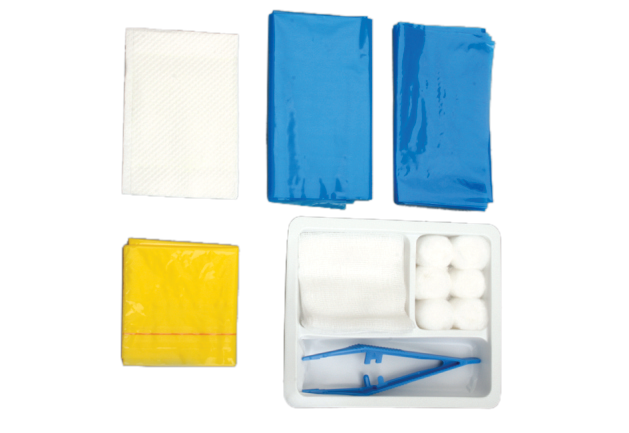
Basic Dressing Set
In medical facilities, a set of surgical instruments is necessary in order to provide essential treatment and care for patients. The Basic Dressing Set is useful because it contains all the basic instruments needed for dressings, allowing the facility to be well equipped and prepared for emergency situations.
1pc Gallipot tray with 3 compartments
6pcs Cotton wool balls 0.5gm
4pcs Gauze swabs, 13 thread, 7.5×7.5cm
1pc Dissecting forcep
1pc Waterproof drape
1pc Sterile field
1pc Hand towel
1pc Limpet bag
Basic dressing sets are a must-have for any well-equipped medical facility. They typically include a variety of gauze pads, Band-Aids, and other adhesive bandages, as well as sterile dressings and wraps. Basic dressing sets are an essential part of any medical facility's inventory because they can be used for a wide variety of purposes. They can be used to treat minor cuts and scrapes, or they can be used to cover more serious wounds. They can also be used to protect wounds from infection. No matter what the purpose, basic dressing sets are a vital part of any medical facility's supplies. Without them, patients would not be able to receive the care they need.
There are a few different types of basic dressing sets that are typically used in medical facilities. The most common type is the standard gauze dressing set, which includes gauze pads, tape, and scissors. This type of set is typically used for minor cuts and scrapes. Another type of basic dressing set is the trauma dressing set, which is designed for more serious injuries. This type of set usually includes larger gauze pads, a roll of gauze, and an elastic bandage. This type of set is typically used for major wounds or burns. A third type of basic dressing set is the first aid dressing set, which is designed for more general first aid purposes. This type of set usually includes a variety of different size gauze pads, a roll of gauze, adhesive bandages, and antiseptic wipes. This type of set can be used for a variety of different incidents, from minor cuts and scrapes to more serious injuries.
A basic dressing set is a must-have for any well-equipped medical facility. It is a versatile and essential tool that can be used for a variety of purposes, from wound care to infection control.
There are many reasons why a medical facility would need a basic dressing set.
First, it can be used for wound care. The dressing set can be used to clean and dress wounds, as well as to apply pressure to stop bleeding. Additionally, the dressing set can be used to protect wounds from further contamination.
Second, the basic dressing set can be used for infection control. The dressing set can be used to disinfect wounds and to prevent the spread of infection. Additionally, the dressing set can be used to isolate infected patients from non-infected patients.
Third, the basic dressing set can be used for general patient care. The dressing set can be used to take care of minor cuts and scrapes, as well as to apply ointments and medications. Additionally, the dressing set can be used to provide comfort to patients who are experiencing pain or discomfort.
The basic dressing set is an essential tool for any well-equipped medical facility. It is versatile and essential for a variety of purposes, from wound care to infection control.
One of the most important things that medical facilities can do to prevent infection is to make sure that they are well-equipped with basic dressing sets. By having a good supply of sterile dressings on hand, medical staff can quickly and easily change wound dressings, keeping wounds clean and free from infection. Of course, it is not only important to have sterile dressings available, but also to know how to properly apply them. Medical staff should be trained in proper wound care techniques, including how to clean and disinfect wounds before applying a new dressing. By taking these simple steps, medical facilities can help to prevent infection and keep patients safe.
One of the most important aspects of maintaining a clean and well-equipped medical facility is preventing cross contamination. Cross contamination can occur when different body fluids or substances come into contact with each other, which can lead to the spread of infection. One way to prevent cross contamination is to use basic dressing sets. Basic dressing sets typically include items such as gloves, gowns, masks, and drapes. These items are designed to protect the patient and medical staff from coming into contact with each other's body fluids. By using basic dressing sets, you can help to prevent the spread of infection and keep your medical facility clean and safe.